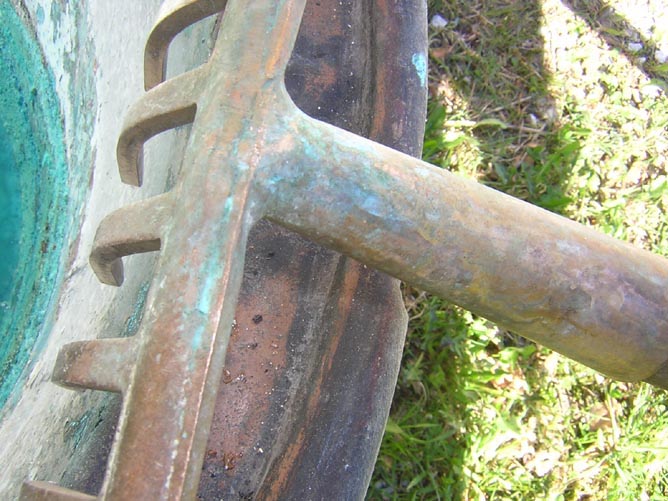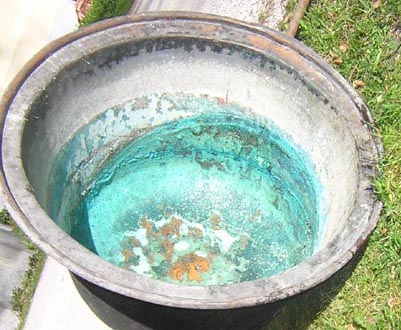-
I thought copper was a soft metal. Does it stand up to normal garden use?
In its pure form, copper would be too soft a metal for most garden tools.
However, our tools are made of a range of copper alloys. The blades of all of the tools are solid bronze, containing over 90% copper. The remaining part is tin. Bronze is more hardwearing and keeps its sharp edge better than pure copper. The collars of Sirius, Tuza, Hydra and Pegasus also have parts of brass, an alloy of copper and zinc. The collars of Phoenix, Polux and Lyra are pure copper.
-
Why Copper?
-
-
-
PKS gardening tools enrich the soils with coppertrace elements and thereby provide plants with essential nutrients
-
They are hardwearing and will last for years
-
Stay free of rust – but age with a graceful bronze patina, perfect for the coastal gardener
-
They have sharp edges
-
They have an incomparably longer lifespan than devices from iron
-
Minute amounts of copper create the conditions for beneficial micro-organisms
-
Penetrate the soil easily -low coefficient of friction- less tendency for clay to cling to the tool
-
Bronze is not magnetic – so does not disrupt the electrical fields in the soil
-
Can be kept sharp with a whetstone, file or by peening (hammering the edge against a steel anvil)
-
Are a pleasure to own and use
-
-
-
-
Won’t the copper go green over time?
No. The green is verdigris, which is formed when copper comes into contact with acid. Copper roofs have verdigris because rainwater with its absorbed carbon dioxide is naturally slightly acidic. Groundwater is not naturally acidic. Even acid soil is not acidic enough to cause verdigris. Our tools acquire a slight brown patina over time, that can be cleaned off with a metal polish if you want to restore the original shine.
Patina
Is a grey-green surface layer on copper and copper alloys, which consists of basic carbonates and sulfates. This layer forms when in reaction with the carbon and sulfur dioxide contained in air. Patina protects copper against decomposition. In its salient green form the patina, dependent on rain quantity and water composition, appears after approximately 8 to 15 years on flat surfaces that are strongly exposed to rain.Verdigris
is a mixture of basic green or blue copper acetates, which settles on copper or brass. It develops as a result to longer influence of weak acids with mostly organic compounds. Food remainders (fruit acid, acetic acid) as well as animal eliminations (urine acid) are included in the above-mentioned category.
Unfortunately these two terms are often confounded and that is why it is frequently said that poisonous verdigris might develop itself on copper garden-devices. In reality a protecting patina layer forms on the devices; this layer protects them and guarantees a long life span. It is out of the question that the food remainders mentioned in the definition above, which can be found in the compost and also be regarded as possible source of organic acids, are the ones causing the verdigris in the practical horticulture. Verdigris develops due to longer effect of acids on copper. Neither the concentration of possibly available acids by food composting nor the duration of the contact between the metal and these acids would facilitate the formation of poisonous verdigris.The above remarks also contradict the beliefs that food, which proceeds from own horticulture by using copper soil-tilling machines, could be a danger in the nutrition of infants.
Further general information on copper at: www.copperinfo.com
-
How long do the tools last?
These are long lasting tools which should out last most of us.
We provide a 10 years guarantee on the metal parts. For the wooden handles 2 years.
This does not apply to wear and tear.
We will refund or replace any unused tool. We will also repair or replace any faulty tool. Of course this excludes normal wear and tear. The handles and shafts are guaranteed for two years, and we also supply replacements.
-
When I activated my rake in the spring, he had a green discoloration?

The rake shows definitely no verdigris, these green dyes are oxidation products, such as occur on copper surfaces in humid environments. This staining is not critical in any way, so irrelevant, if it does not bother the owner for aesthetic reasons. Otherwise cleaning could both brass wire brush, or cleaning fluids are used (see below).

The tank contained a fluid that reacted with copper. Only if it was this liquid to acetic acid, could have developed verdigris. In this case, the coloring products would, however, water soluble, and thus also been removed with the emptying of the boiler. I suspect that the vessel containing alkaline substances, which worked over a longer period, and these blue–green colors evoked:
These products consist mainly of carbonates of copper, potassium and sodium, with varying silicate content. They are nontoxic. Polluters are flushing with fresh mortar, plaster and concrete slabs during the setting process, possibly also from gravel beds (ie, the boiler was in the damp room, for example to collect the leakage in the concrete ceiling?). Alkaline cleaners may also be involved. With the decline of alkaline washing out any new blue-green oxidation products are more on the copper surface. As they disappear on the other hand, not even saying that brushing with a stainless steel or brass wire brush and rinse with water is recommended. Finer dirt e.g. with special protall removed.
The discolorations occur for the reasons then not again.
After a cleaning of the boiler you will know very well that the surface of the material surface was not affected by this: the bare copper reappears. This is a clear indication that this flushing have no material adverse effect, but the copper is affected only in its decorative appearance.
Antwort von Dipl.-Ing. M. Werner – Deutsches Kupferinstitut e.V. www.kupferinstitut.de
-
Rain water from copper gutters is favorable for watering the garden?
Rainwater that has run over copper gutters contain due to the short residence time in the gutter only very little copper ions and can therefore, like rain water from other channels are used equally. Its advantage as an essential trace element, the copper can hardly ausspielen.Selbstverständlich to the consumer should be independent of the material of the gutter, aware that in this collected rain water contamination by debris on the roof surface, dust, bird droppings, etc. are included and these ingredients could have an impact on his plants.
Antwort von Dipl.-Ing. M. Werner – Deutsches Kupferinstitut e.V. www.kupferinstitut.de